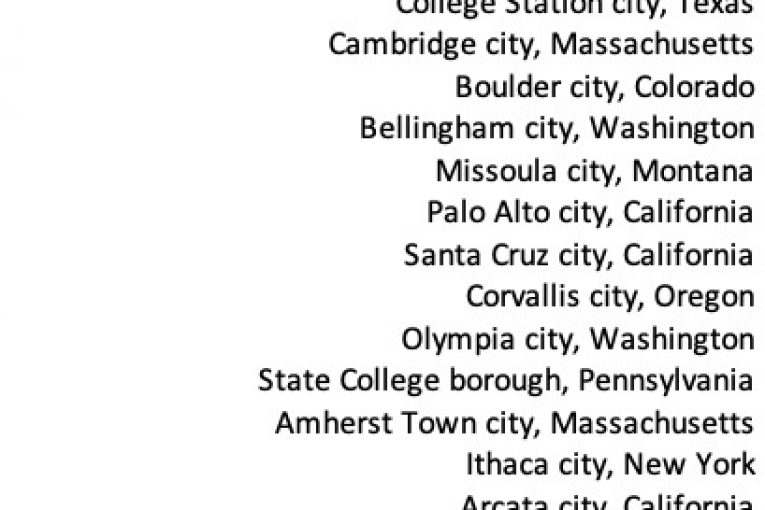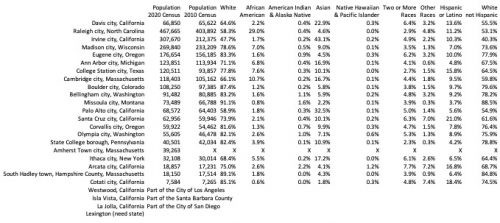
 by Matt Williams
by Matt Williams
On Monday I posed the following question to all Vanguard readers. The full article can be read HERE
“Do the people in Davis who are advocating for change have an example of a city in California … or anywhere in the US … that is a model for what they believe Davis needs to be?
For the many people in Davis who agree with the headline of the Vanguard’s Friday article “But Davis Is a Great Place, I Don’t Want It to Change” the model for what they believe Davis needs to be is Davis itself. It will be very interesting to hear the answers from the people who believe it is Davis’ manifest destiny to embrace change.
I encouraged everyone who takes up this challenge and provides a model city name (or names), to explain why they think that city is a good model for what they want Davis to become.
Twenty-five city names were suggested, and twenty-one of those had data sets in the US Census. I share below data about the twenty-one sorted by population size … from 467,000 on the high end and 7,500 on the low end. I will be gathering additional data from other US Census sources, and sharing that data in the coming days and weeks.
Feel free to jump in and comment on what you think this first round of data about the suggested cities that are believed to be models of what Davis might aspite to be.
The one disappointment I had with the responses provided on Monday was that there was very little discussion about the strategy/plan that the suggested model cities used to achieve their model status. I encourage commenters to begin to delve into those “how did they get there” questions.


Matt,
I think you’re looking for information that goes beyond your typical commenter here. How a city gets to where they are requires historical fiscal and urban planning knowledge of a city. You’d have to talk to past city Managers, Mayors, Council men and head planners from those example cities. I’ve found is that you’d think urban planning and economic planning would be intricately related but often times are two different but related efforts. I’ve looked for metrics on city fiscal growth and planned urban growth and haven’t found it (from a few planners and developers I know). Often times growth both housing and economic is subject to the circumstances of their times….economic growth in the area then gets a town to grow for a while and then the political winds blow another way and they stop growing. Basically it’s often sort of a piecemeal effort in terms of long term planning (other than the state projects this amount of regional population growth in the next 20 years so we should plan for so much housing….in which case it sort of becomes fait accompli).
One thing I think bares pointing out in the comments are of the “college town” cities….which one’s include the school and the students in the city limits (like Arcata) and which cities have their schools outside of the city limits (like Palo Alto). Cal is in the city of Berkeley as is UC Santa Cruz in the city of Santa Cruz. I think that makes a big difference in urban planning and economic growth policies.
This is useful starting snapshot. (I don’t think the median house value in Raleigh can be $2M–that’s way past San Francisco–both Zillow and Redfin show median values of $387k-$396k. Here’s another source with similar info: https://www.noradarealestate.com/blog/raleigh-nc-real-estate-market/)
I think a useful set of data would be these variables over the 1970 to 2020 period to see how each has evolved. For example, I know that Ann Arbor, Eugene and Bellingham all suffered downswings associated with the auto and timber industries in the 1970s and 80s, which Davis did not experience. Somehow they came back to be more vibrant communities that now outshine Davis.
Largely because Davis has failed to capitalize on UCD
What does this even mean? How do they outshine Davis? Based on what?
Thanks for catching that Richard. I clearly had an Excel sorting problem, and have corrected the graphic of the table. Palo Alto is the city with the values at $2 million+ All the values are from the US Census. I’ll be glad to share the Excel spreadsheet with you. Given how the real estate market has moved in the last 12 months the difference between your $387k-$396k median value and the Census’ $248k average value is not surprising.
I agree that it is a starting snapshot. I will try and get the 1970 through 2000 values. However, I’m not sure that that picture is going to help us going forward. It may very well show how Davis has failed to capitalize on UCD’s creation of intellectual capital … as well as UCD’s failure to partner with its host city on technology transfer from the campus to its host city’s private sector, but there isn’t really anyone that I know of who is disputing that history.
My purpose in putting this exercise forward is to get the community discussing the way forward. Right now, because of the lack of community leadership either from our electeds or any group of non-electeds there is no clearly articulated plan or strategy for going forward or even for where we. as a community, want to be in 10-20 years. As you have pointed out in past comments, this is a community with lots of good ideas, but they haven’t been brought together into a coherent integrated plan.
I believe Keith is absolutely correct when he says “that you’d think urban [land use] planning and economic planning would be intricately related but often times are two different but related efforts.” I also believe he is correct that “often times growth both housing and economic is subject to the circumstances of their times.” My expectation is that the model cities that are well run enough to have achieved both resilience and sustainability in 1) their municipal budget, 2) the maintenance of their streets and buildings and other capital infrastructure, and 3) their local business economy.
That almost surely takes well thought-out planning in two key related areas … (A) their General Plan for urban/land use planning and (B) their Economic Development Plan so that the thriving collaboration between the municipality (the City), the private sector businesses, and the local university (since all the model cities proposed thus far have a university close by.
The community? Do you mean the 8 or 9 Vanguard commenters?
That is a fair criticism Keith; however, I do not plan on stopping simply with the Vanguard readership. The question needs to be engaged (in my opinion) broadly across all of Davis.
This just happens to be a good starting venue for the first round of discussion … and the initial suggestions of model cities. It has already borne fruit in my opinion.
Most of the demographics you’re after for Amherst, MA are available at https://censusreporter.org/profiles/06000US2501501325-amherst-town-hampshire-county-ma/